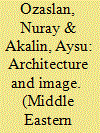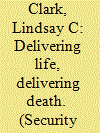| Srl | Item |
| 1 |
ID:
108259


|
|
|
|
|
| Publication |
2011.
|
| Summary/Abstract |
Since the 1980s, through the creation of image-dependent products, the advertising industry in metropolitan areas of Turkey has followed new tastes by manufacturing collective identities promising 'a different lifestyle'. This has been achieved by promoting either images of past (historical) forms or of different cultures and claiming that these images represent a better future in the social network of consumption. This article presents an historical perspective on the transformation of Turkish architecture in the postmodern from an historical and cultural representation of society to the 'ordinary' and the 'clichéd'. Now buildings are made to appear 'historical' in an attempt to look different. Architecture turns into making an image that is easy to exchange, buy and sell.
|
|
|
|
|
|
|
|
|
|
|
|
|
|
|
|
| 2 |
ID:
183728


|
|
|
|
|
| Summary/Abstract |
Like all warfare, drone warfare is deeply gendered. This article explores how this military technology sediments or disrupts existing conceptualizations of women who kill in war. The article using the concept of motherhood as a narrative organizing trope and introduces a ‘fictional’ account of motherhood and drone warfare and data from a ‘real life’ account of a pregnant British Reaper operator. The article considers the way trauma experienced by Reaper drone crews is reported in a highly gendered manner, reflecting the way women’s violence is generally constructed as resulting from personal failures, lost love and irrational emotionality. This irrational emotionality is tied to a long history of medicalizing women’s bodies and psychologies because of their reproductive capacities and, specifically, their wombs – explored in this article under the historico-medical term of ‘hysteria’. The article argues that where barriers to women’s participation in warfare have, in the past, hinged upon their (argued) physical weakness, and where technology renders these barriers obsolete, there remains the tenacious myth that women are emotionally incapable of conducting lethal operations – a myth based on (mis)conceptions of the ‘naturalness’ of motherhood and the feminine capacity to give life.
|
|
|
|
|
|
|
|
|
|
|
|
|
|
|
|